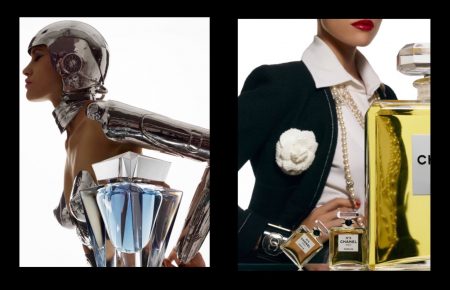
Mugler and Chanel Fashion© Thomas Lagrande for Paris Vogue, 2015 collage by Marianne©
We call them designer perfumes for a reason. Fashion brands like Versace, Chanel and Thierry Mugler have entered popular culture just that deeply, whether in a George Michael video or the iconic Chanel suit; their fragrances reflect their recognizable DNA. Versace is silky and intense; Chanel is luxurious and restrained. Across the fragrance aisle, customers may recognize a designer’s name, but not even know that the brand has a strong presence in fashion. I’ll guess more people know Narciso Rodriguez and Stella McCartney from their names on a bottle than a label in a garment. In the vintage perfume realm, many classic perfumes are outliving the memory of the fashion behind them, but the thumbprint is there, nevertheless.
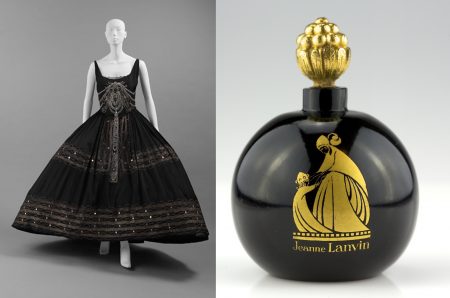
Lanvin Robe de Style, ca. 1925 © Metropolitan Museum of Art
Lanvin was behind Chanel by only a few years in creating the fashion house’s first perfume. As their fashion differed, so did their perfume. Chanel No. 5 is balanced and composed with nothing extraneous about it – very much like a simple chemise which Coco Chanel sold in her boutique where she debuted No. 5 in 1921. On the other hand, Jeanne Lanvin wasn’t shy with volume and trims. Lanvin was famous in the 1920s for designing a garment she called the “robe de mode”, a dress with a tight stomacher-type bodice above a very full skirt. There is an extravagance about these dresses that is reflected in the sumptuous florals of Arpège. In 1927 Lanvin’s newly employed in-house perfumers, André Fraysse and Paul Vacher, under the direction of Jeanne Lanvin herself, created a perfume for customers who were interested in luxurious femininity. (In actuality it was designed for her daughter.) Armand-Albert Rateau designed the famous Lanvin boule bottle with its satisfying volume. He even used the classic black and gold Mme Lanvin favored.
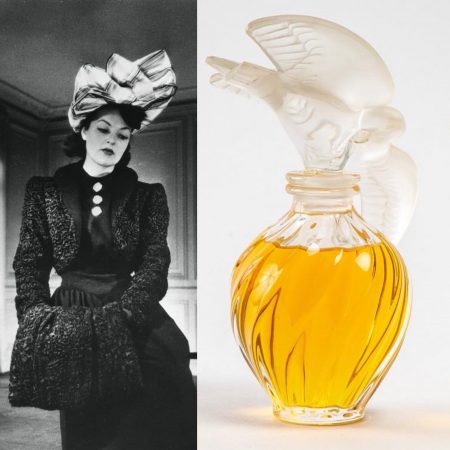
Nina Ricci suit and hat, 1943 from the collection of Meister Drucke
After a global economic depression and World War II, women looked for ways to lighten their lives and celebrate peace. Nina Ricci gave them L’Air du Temps. Italian-born Mme Ricci, a single mother raising her son Robert in Paris, supported herself for decades by designing for another fashion house. Not until she was 49, at the urging of her business savvy son, Robert, did she open the House of Ricci. Her clientele were not sylphs of the chic Parisian moneyed class, but rather upper-middle-class women outside the capital, looking for affordable style. Although talented, Nina Ricci never received the attention and respect of the fashion establishment. Her customers were the very women who had carried the most burden during the early part of the century, and there were a lot of them. Robert Ricci was anxious to expand the business on an international scale with perfume as his launchpad. Nina Ricci’s “Coeur Joie” was a success, but it was the affordable “L’Air du Temps” that was a worldwide success he was looking for and has become an enduring classic. Fabrice Fabron composed a delicate and romantic classic that was accessible to many women, not just to society’s elite.
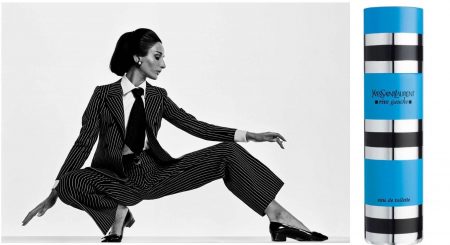
Yves Saint Laurent suit, 1967 © Frank Horvat for Harper’s Bazaar
A generation later, women were reclaiming the place in the world that they had tasted briefly during the wartime 1940s. Nina Ricci who had paved the way with her demi-Ready-to-Wear collections passed the baton to Yves Saint Laurent. Yves Saint Laurent translated the burgeoning feminist movement into fashion. In the late 1960s, he introduced his Rive Gauche clothing line, the first successful Ready-to-Wear line to emerge from Parisian couture. In 1970 Saint Laurent launched a perfume for his modern concept, “Rive Gauche.” Michel Hy and Jacques Polge created a fragrance as crisp and alert as the strong women of Saint Laurent’s clothing. The legendary bottle designer, Pierre Dinand, created a sleek, utilitarian but chic, aluminum canister for Rive Gauche. Perhaps the most formative 30 seconds of my childhood were a “Rive Gauche” TV ad. A smartly dressed woman with her hand on the shift of convertible sports car speeds along to the ad’s song, “… The girl that’s so contemporary, she’s having too much fun to marry! She’s not sitting home by the phone, if she wants to go she goes alone.” As the tag line “Rive Gauche: Nothing like the past” plays, her hand slams down that powerful Dinand bottle in the middle of a sea of delicate clear bottles of amber liquid.
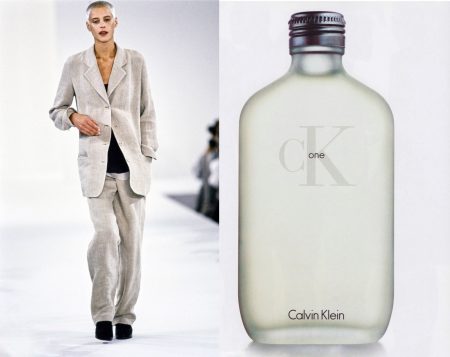
Calvin Klein linen suit, Spring 1994 © Vogue
Calvin Klein edged his feminist aesthetic from the female empowerment of Saint Laurent toward one of androgynous equality. Calvin Klein is one of the designers who is nowhere near as God-like as he was 40 years ago when his soft silhouettes were instantly recognizable. Cosmetic firms had tried for years to snag the rights to a Calvin Klein fragrance, but none would cede the full artistic control that Klein demanded. So, he bankrolled his own fragrance in 1977, hiring Carlos Benaïm to create “Calvin Klein.” After success with “Obsession” in his 1980s jean and underwear period, Calvin Klein released a groundbreaking perfume composed by Harry Frémont and Alberto Morillas, “CK One”. It would become known as the first unisex fragrance. Calvin Klein’s collections of that time were gender-neutral and clean, as was the fragrance. “CK One” is as easy to wear as one of the linen shifts he sent down the runway in the mid-’90s.
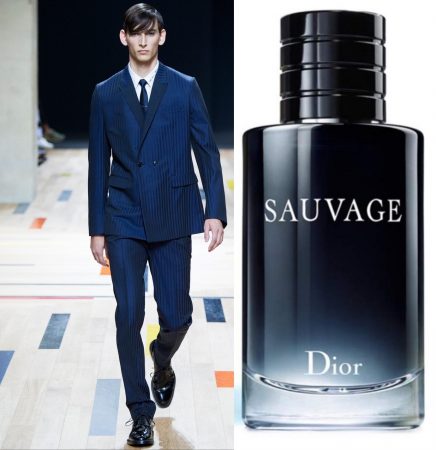
Dior Homme navy suit, Fall 2015 © Vogue
A nipped waist, full skirt, and bottle of “Miss Dior” are what I see when I hear the name Christian Dior. The Dior brand has deservedly had a revered position in fashion since M. Dior gave us the New Look in 1947. A short ten years later Christian Dior had passed away. Fortunately, after a sputter or two, Marc Bohan took the helm at the house of Dior. In 1966 Edmond Roudnitska signed Dior’s eau de toilette for men, Eau Sauvage, which is beloved to this day. Marc Bohan debuted Dior’s first menswear line which was very much in keeping with Eau Savauge’s crisp masculinity (think a European-cut Don Draper). In 2015 ,Dior revisited the fragrance, and released “Sauvage” signed by François Demachy. It cannot be a coincidence that Dior Homme’s Fall 2015 collection was ’60s cut suits with modern accessories. It was spectacular. Let’s not debate which concentration of “Sauvage” is as spectacular. Or compare it to” Eau de Savage” … much blood and ink would be spilled. Simply said, people are passionate about Sauvage.
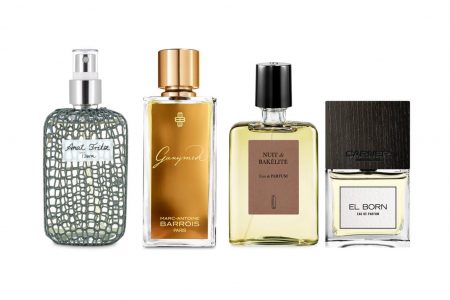
Anat Fritz Tzora, Marc-Antoine Barrois Ganymede, Naomi Goodsir Nuit de Bakelite and Carner Barcelona El Born
No doubt you have at least one of these independent fragrances on your perfume shelf: “Ganymede”, “Nuit de Bakélite”, “Tzora” or “El Born”. All are brainchildren of Creative Directors known for non-perfume design. Marc-Antoine Barrois (Ganymede) designs modern bespoke suits. Naomi Goodsir (Nuit de Bakélite) is best known for clothing and millinery design. Anat Fritz’s bottles for “Tzora” are encased in unique netting reminiscent of her knitwear designs. Sara Carner (El Born) is from a family that has created fine leather goods for generations.
As long as we have artists creating fashion, they will be creating fragrance… even if we don’t call them designer perfumes.
–Marianne Butler, Senior Contributor
All perfume bottle photos appear courtesy of the brands.
